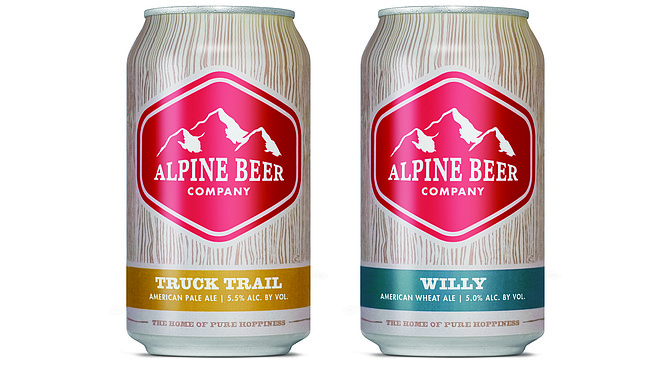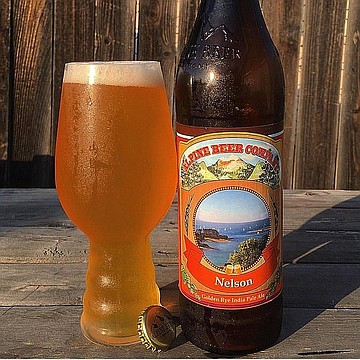 Facebook
Facebook
 X
X
 Instagram
Instagram
 TikTok
TikTok
 Youtube
Youtube

We're not even four years removed from a time that Alpine Beer Co. beers were hard to get. Prior to 2013, the small, way–East County brewery only made 1500 barrels per year, and craft enthusiasts had to drive to Alpine, 30 miles outside San Diego, to get it.
Today, Alpine beers may be found in all 50 states and 26 countries; several are available in six-packs; by the summer, two of its ales will be released in cans.
Of course, this has everything to do with Green Flash Brewing. Since the much larger local company bought Alpine in late 2014, it’s put standout Alpine beers into wide release. Green Flash won't reveal what percentage of the 91,000 barrels it brewed in 2016 were Alpine beers, but it's enough that the once tough-to-find Alpine brand now may be found almost everywhere, every day.
That's a significant change for a business accustomed to seeing demand far outreach supply. "We've always maintained the philosophy, ‘Give the public what they want, but just enough to keep them wanting more,’” says Alpine's head brewer, Shawn McIlhenney.
That's a tough position to maintain when Green Flash's East and West Coast facilities can produce in a week what Alpine's original microbrewery makes in a year; however, the subsidiary brewery strives to make the dichotomy work.

McIlhenney still spends most of his brew days in the original brewhouse location, working in small batches to the tune of 2000 barrels a year. This year, some of that beer will go toward seasonal, tasting-room-only bottle releases of fan favorites like Exponential Hoppiness and Bad Boy double IPAs. However, much of the work comprises research and development, creating limited-quantity brews that continue to give dedicated fans good reason to make a pilgrimage to Alpine. "We always want to be on the forefront of what's new," McIlhenney explains. "We want to be the trend-setters and not the trend-followers."
That trend-setting goes back to 2005, when Alpine became one of the first craft breweries to work with a little-known New Zealand hop variety called Nelson Sauvin. It produced Nelson rye IPA, a beer also ahead of its time for another reason. "We've been making a hazy IPA well before anybody thought it was cool," McIlhenney recalls. "We tried our best to make that beer clear, normal…. It was always hazy no matter what we did."
But Nelson's immediate impact was raising demand for the Nelson Sauvin hop so high, even Alpine struggled to get ahold of it. "That became a problem," McIlhenney remembers. "We needed a lot more than we could actually contract."
He reveals that difficulty securing hop contracts has been a major boon of Alpine's sale to a larger business. "Because of the acquisition of our company by Green Flash," he says, "we've opened ourselves up to more buying potential."
Including Nelson. While Alpine must still ration its Nelson hops supply to sporadic, limited releases of Nelson IPA in 2017, McIlhenney recently returned from a trip to New Zealand to negotiate for a much larger supply in 2018. "If the contracts come through as we hope, we might actually have it available year round."


We're not even four years removed from a time that Alpine Beer Co. beers were hard to get. Prior to 2013, the small, way–East County brewery only made 1500 barrels per year, and craft enthusiasts had to drive to Alpine, 30 miles outside San Diego, to get it.
Today, Alpine beers may be found in all 50 states and 26 countries; several are available in six-packs; by the summer, two of its ales will be released in cans.
Of course, this has everything to do with Green Flash Brewing. Since the much larger local company bought Alpine in late 2014, it’s put standout Alpine beers into wide release. Green Flash won't reveal what percentage of the 91,000 barrels it brewed in 2016 were Alpine beers, but it's enough that the once tough-to-find Alpine brand now may be found almost everywhere, every day.
That's a significant change for a business accustomed to seeing demand far outreach supply. "We've always maintained the philosophy, ‘Give the public what they want, but just enough to keep them wanting more,’” says Alpine's head brewer, Shawn McIlhenney.
That's a tough position to maintain when Green Flash's East and West Coast facilities can produce in a week what Alpine's original microbrewery makes in a year; however, the subsidiary brewery strives to make the dichotomy work.

McIlhenney still spends most of his brew days in the original brewhouse location, working in small batches to the tune of 2000 barrels a year. This year, some of that beer will go toward seasonal, tasting-room-only bottle releases of fan favorites like Exponential Hoppiness and Bad Boy double IPAs. However, much of the work comprises research and development, creating limited-quantity brews that continue to give dedicated fans good reason to make a pilgrimage to Alpine. "We always want to be on the forefront of what's new," McIlhenney explains. "We want to be the trend-setters and not the trend-followers."
That trend-setting goes back to 2005, when Alpine became one of the first craft breweries to work with a little-known New Zealand hop variety called Nelson Sauvin. It produced Nelson rye IPA, a beer also ahead of its time for another reason. "We've been making a hazy IPA well before anybody thought it was cool," McIlhenney recalls. "We tried our best to make that beer clear, normal…. It was always hazy no matter what we did."
But Nelson's immediate impact was raising demand for the Nelson Sauvin hop so high, even Alpine struggled to get ahold of it. "That became a problem," McIlhenney remembers. "We needed a lot more than we could actually contract."
He reveals that difficulty securing hop contracts has been a major boon of Alpine's sale to a larger business. "Because of the acquisition of our company by Green Flash," he says, "we've opened ourselves up to more buying potential."
Including Nelson. While Alpine must still ration its Nelson hops supply to sporadic, limited releases of Nelson IPA in 2017, McIlhenney recently returned from a trip to New Zealand to negotiate for a much larger supply in 2018. "If the contracts come through as we hope, we might actually have it available year round."
Comments